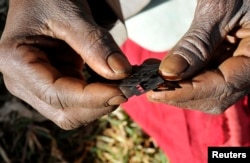Millions more girls and women worldwide are victims of female genital mutilation than previously thought, according to UNICEF, the U.N. children's agency.
A report released Thursday says at least 200 million girls and women alive today have undergone ritual cutting, half of them living in just three countries — Egypt, Ethiopia and Indonesia.
The latest figures include nearly 70 million more girls and women than estimated in 2014, because of a raft of new data collected in Indonesia, where the practice has been banned since 2006.
Somalia has the highest prevalence of women and girls who have been cut — 98 percent of the female population between the ages of 15 and 49. Guinea, Djibouti and Sierra Leone also have very high rates.
Some 44 million victims of female genital mutilation around the world are aged 14 or younger, and the majority of girls who have had their genitals mutilated were cut before they were 5 years old, UNICEF's research found.
"In Yemen, 85 percent of girls experienced the practice within their first week of life,'' the report said.
Hard to track
UNICEF says exact numbers are hard to come by, because few of the 30 countries where it is practiced keep reliable data on the procedure, relying primarily on household surveys.
The practice also exists in countries not in the study, such as India, Malaysia, Oman, Saudi Arabia and the United Arab Emirates, as well as in pockets of Australia, North America and Europe, where immigrants from countries with a large number of female circumcisions live.
The good news from the report is that, overall, prevalence rates have fallen in the last three decades, but progress has been uneven. Countries that have seen sharp declines include Liberia, Burkina Faso and Kenya.
The U.N. General Assembly unanimously approved a resolution in December 2012 calling for a global ban on female genital mutilation, a centuries-old practice stemming from the belief that circumcising girls controls women's sexuality and enhances fertility. One of the targets in the new U.N. goals adopted last September calls for the practice to be eliminated by 2030.









